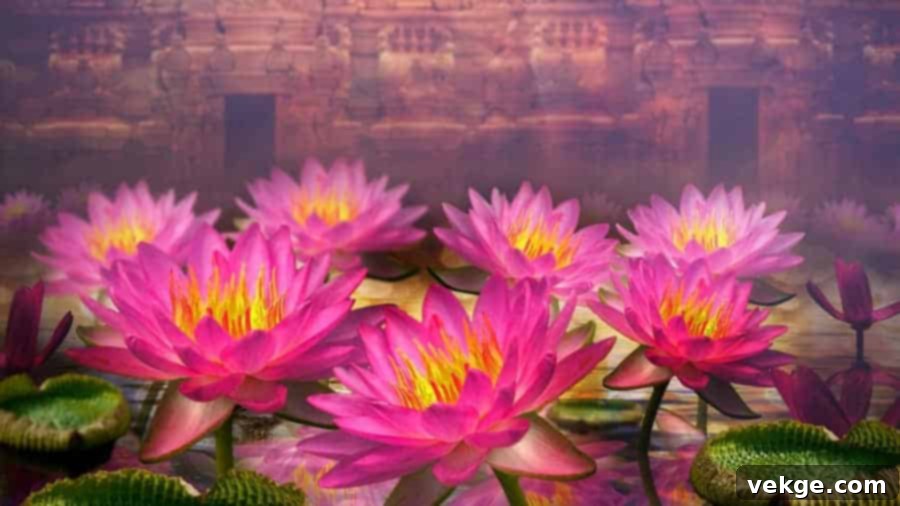The Profound Meaning of the Lotus Flower: Symbolism, History, and Modern Relevance
The lotus flower, a breathtaking marvel of nature, gracefully emerges from the murky depths of ponds and lakes, its pristine petals untouched by the mud below. This incredible transformation has captivated human imagination for millennia, establishing the lotus as a universal emblem of wonder, spiritual growth, and profound reverence. Its journey from the obscure, muddy bottom to a radiant, unblemished bloom serves as a powerful metaphor for humanity’s inherent capacity for renewal, resilience, and spiritual enlightenment.
From the foundational mythologies of ancient civilizations to the contemplative practices of modern cultures, the lotus holds a special, cherished place in our collective hearts and minds. Its elegant defiance of its humble origins mirrors our own potential to transcend life’s challenges and achieve a state of inner purity and self-realization. Far more than just a beautiful aquatic plant, the lotus flower’s meaning delves into core themes of purity, rebirth, spiritual awakening, and the triumphant spirit over adversity.
Are you eager to uncover the deeper significance of this extraordinary botanical icon? Join us on an immersive journey as we explore the mystical and multifaceted world of lotus flowers, revealing the rich tapestry of symbolism and profound cultural importance that has firmly established this aquatic plant as an enduring symbol of hope, transformation, and timeless beauty across the globe.
Historical and Cultural Significance of the Lotus Flower
The lotus flower carries immense spiritual and cultural weight across a diverse array of ancient traditions and major world religions, most notably finding deep roots in Buddhism, Hinduism, and the civilization of Ancient Egypt. Its symbolic presence in these cultures underscores its universal appeal as a representation of profound spiritual truths.
1. Buddhism: The Path to Enlightenment

In the philosophical and spiritual traditions of Buddhism, the lotus flower is inextricably linked to the Buddha himself and the journey towards spiritual enlightenment (Bodhi). The flower’s remarkable growth cycle – rising from the dark, muddy waters to unfurl its petals cleanly and beautifully above the surface – serves as a profound allegory for the process of achieving enlightenment.
This natural phenomenon brilliantly illustrates how individuals can courageously rise above the suffering, attachments, and defilements of the material world to attain a state of spiritual purity and inner peace. The lotus thus symbolizes the purity of body, mind, and spirit, embodying detachment from worldly troubles, negativity, and the illusions of existence. Its ability to remain unstained, despite its muddy environment, represents the wisdom to navigate life without being entangled by its impurities.
Furthermore, the lotus flower’s daily ritual of closing its petals at night and reopening them with the first light of dawn powerfully represents rebirth, regeneration, and spiritual awakening. Each morning offers a fresh start, a renewed opportunity for growth and enlightenment.
Different lotus colors in Buddhism carry specific, nuanced meanings:
- The white lotus is the epitome of purity, mental clarity, and spiritual perfection. It signifies the peaceful state of being that results from an enlightened mind.
- The pink lotus is particularly revered and is traditionally associated with the Great Buddha himself, representing his earthly existence and teachings.
- The red lotus symbolizes love, compassion, and the purity of the heart.
- The blue lotus, often depicted as partially open, represents wisdom, knowledge, and the victory of the spirit over the senses, embodying spiritual mastery.
2. Hinduism: Divine Beauty and Cosmic Creation

Within the rich tapestry of Hinduism, the lotus flower is intimately connected with numerous significant deities and central philosophical concepts. It is frequently associated with Lakshmi, the goddess of wealth, prosperity, and purity, who is often portrayed either seated upon a majestic lotus throne or gracefully holding lotus flowers in her hands. Similarly, Lord Vishnu, the preserver of the universe, is depicted with the lotus, symbolizing his divine nature, beauty, and cosmic creation. Lord Brahma, the creator god, famously emerged from a lotus that grew from Vishnu’s navel, cementing the lotus’s role in creation myths.
In Hindu tradition, the lotus flower symbolizes an expansive array of virtues, including beauty, fertility, prosperity, and eternal life. It represents the ideal of a person who performs their duties (dharma) without attachment to the outcomes or rewards, much like how the lotus itself remains unsullied and detached despite growing in muddy waters. This concept highlights spiritual purity and freedom from worldly desires.
Beyond its divine associations, the lotus holds profound significance in Hindu tantra and yogic philosophy, where it represents the body’s energy centers, known as chakras. Each chakra, from the base of the spine to the crown of the head, is visualized as a lotus with a specific number of petals, blooming as spiritual energy ascends. For instance, the root chakra (Muladhara) is often a four-petaled lotus, while the crown chakra (Sahasrara) is represented as a thousand-petaled lotus, symbolizing ultimate spiritual awakening and cosmic consciousness.
3. Ancient Egypt: Rebirth and Creation
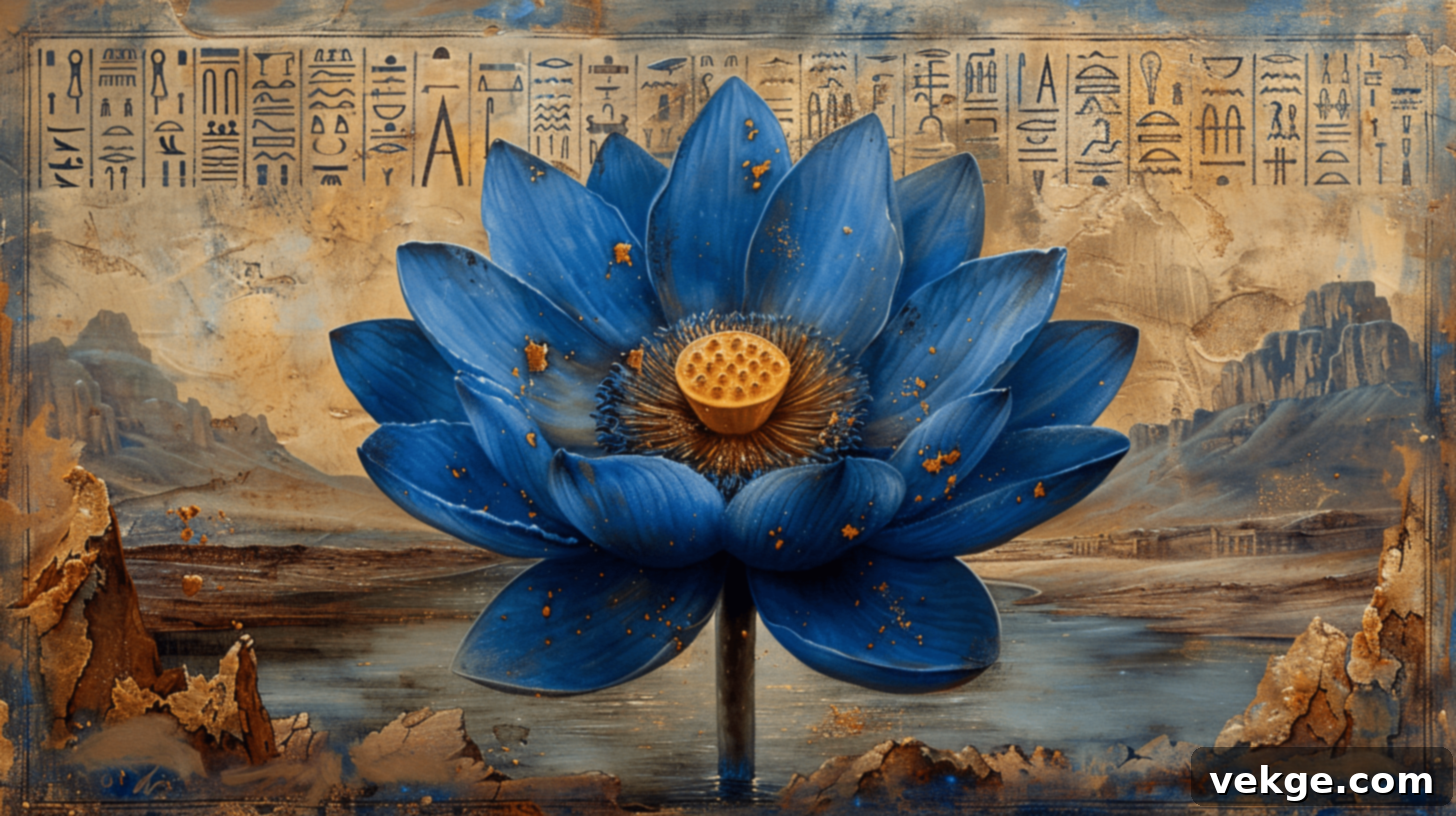
In the fascinating civilization of Ancient Egypt, the lotus flower held powerful symbolism associated with rebirth, regeneration, and the very act of creation. This symbolism was intricately tied to the life-giving Nile River and the daily cycle of the sun. The Egyptians keenly observed how lotus flowers, particularly the blue lotus, closed their petals at dusk and sank beneath the water, only to majestically reopen and rise to the surface with the morning sun, mirroring the sun’s journey across the sky and its daily rebirth.
The blue lotus (Nymphaea caerulea) was especially revered in Ancient Egypt. It thrived abundantly along the banks of the Nile, becoming a potent symbol of fertility, abundance, and the eternal cycle of life and death. Sadly, this iconic variety is now critically endangered. The lotus played a central role in Egyptian creation myths; it was believed that the primordial god Nefertem emerged from a lotus flower at the dawn of creation, bringing light and fragrance to the world. Consequently, lotuses are prominently featured in Ancient Egyptian art, hieroglyphs, temple carvings, and funerary rituals. They were often depicted alongside pharaohs, queens, and gods, highlighting their sacred status and connection to royalty, divinity, and the promise of eternal life in the afterlife.
This rich and enduring cultural and historical significance across these diverse and influential civilizations unequivocally demonstrates how the lotus flower’s meaning transcends geographical boundaries and historical epochs, establishing it as a truly universal symbol of spiritual growth, profound renewal, and humanity’s timeless quest for meaning.
Lotus vs. Water Lilies: Unraveling the Aquatic Distinction
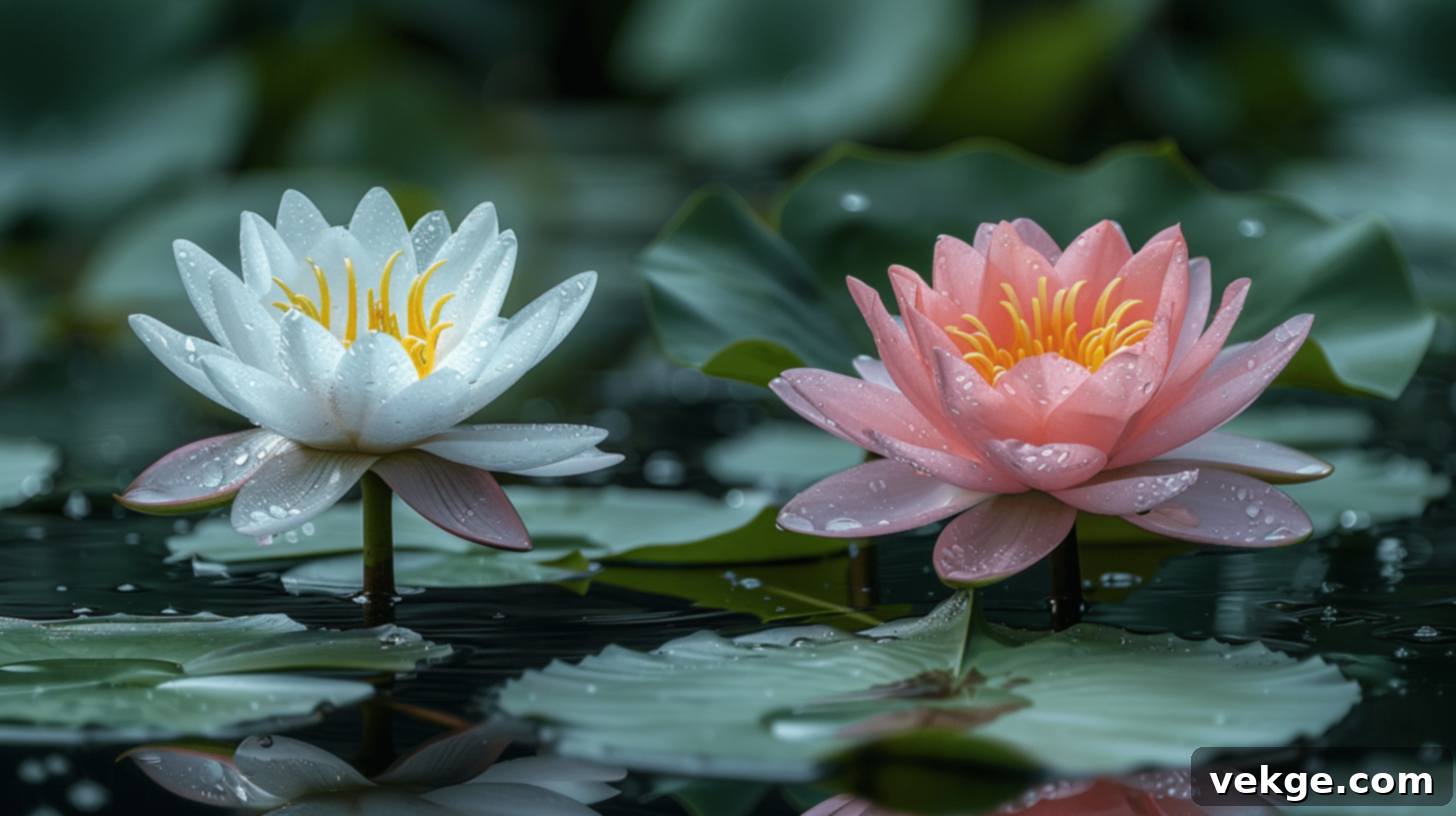
While lotus flowers and water lilies are both stunning aquatic plants that often inhabit similar environments and might appear strikingly similar at first glance, they possess distinct botanical differences that set them apart. Understanding these distinctions enriches our appreciation for each plant’s unique characteristics and ecological roles.
1. Family and Growth Patterns: Above vs. On the Surface
The primary botanical difference lies in their classification and growth habits. Lotus flowers belong to the Nelumbonaceae family, a distinct group characterized by its unique stem structure. In contrast, water lilies are members of the Nymphaeaceae family. This classification difference dictates their growth patterns and how they interact with their aquatic environment.
Lotus plants are rooted firmly in the mud at the bottom of shallow ponds, lakes, or slow-moving rivers. Their most distinctive feature is their strong, erect stems, which push their leaves and magnificent flowers high above the water’s surface, sometimes by several feet. This “rising above” posture is central to the lotus’s spiritual symbolism.
On the other hand, water lilies typically feature leaves that lie flat and float directly on the water’s surface, forming the classic “lily pad” aesthetic. Their delicate flowers usually sit either just above or directly upon the water’s surface, anchored by stems that are often less rigid than those of the lotus.
2. Appearance and Structure: Cups vs. Stars
The visual appeal and structural details of their flowers and leaves also provide clear distinctions. Lotus flowers generally appear larger, more robust, and more dramatic than water lilies. Their petals are broader, often rounded, and open widely to form a distinct cup-like or bowl-shaped bloom. Lotus leaves are also highly characteristic – large, circular, and highly water-repellent, often held majestically high above the water’s surface, glistening with trapped water droplets.
Water lily flowers tend to be smaller, more star-shaped, and flatter, with pointed or narrower petals. Their leaves are more typically oval- or heart-shaped, with a distinctive V-notch where the stem attaches, and they almost always rest directly on the water’s surface, creating a verdant carpet.
3. Color Variations: Subtle Palette vs. Vibrant Spectrum
Both genera offer a beautiful range of colors, but their palettes differ. Lotuses typically come in classic hues of white, pink, various shades of yellow, and occasionally red. Each of these colors carries profound symbolic meaning, particularly within Buddhist and Hindu traditions, as discussed previously.
Water lilies, however, boast a considerably wider and more vibrant color range. They can be found in a dazzling spectrum including white, cream, yellow, various pinks, reds, and even striking shades of blue, purple, and variegated patterns. This expansive variety makes water lilies incredibly popular choices for ornamental ponds and aquatic gardens, where their diverse colors add dynamic visual interest.
While both lotus flowers and water lilies contribute immense beauty to aquatic settings, the lotus’s unique growth pattern – its unwavering ability to rise high above the water’s surface – profoundly underpins its deeper symbolic significance across many cultures, setting it apart as a symbol of transcendence and purity.
Botanical and Historical Insights: A Living Fossil’s Story
The story of the lotus flower is not merely one of symbolism; it’s a tale deeply rooted in geological time, revealing a plant of extraordinary resilience, adaptability, and ancient lineage. Let’s delve into some fascinating botanical and historical insights that highlight the enduring strength of this iconic flower.
Ancient Origins: Dinosaurs and Lotuses

Lotus flowers are not just old; they are truly ancient, considered living fossils. Fossil records unequivocally demonstrate that plants belonging to the Nelumbo genus have existed for an astonishing period spanning over 100 million years. To put this into perspective, these flowers were flourishing and blooming across primeval landscapes when dinosaurs still roamed the Earth during the Cretaceous period. Their remarkable ability to survive through vast geological epochs, including major climate changes, continental shifts, and several mass extinctions, speaks volumes about their incredible adaptability and robust evolutionary success. This ancient lineage contributes to their mystique and symbolic representation of enduring life.
Living Species: Two Noble Varieties

Today, only two recognized living species of lotus exist, each with its own geographical distribution and cultural significance:
- 1. Nelumbo nucifera: The Sacred Lotus
This is arguably the more globally recognized species, native to a vast region encompassing much of Asia (including India, China, and Southeast Asia) and parts of northern Australia. Nelumbo nucifera is the variety deeply ingrained in the spiritual and artistic traditions of Buddhism and Hinduism. Its large, usually pink or white flowers are the quintessential image of the lotus associated with deities, meditation, and enlightenment. It is cultivated for both its ornamental beauty and its widespread culinary and medicinal uses. - 2. Nelumbo lutea: The Yellow Lotus or American Lotus
Often called the American Lotus, this species is indigenous to various regions across North and Central America, ranging from the Great Lakes region down to the Caribbean. While perhaps less famous internationally than its Asian cousin, Nelumbo lutea is equally beautiful, characterized by its striking yellow or pale cream flowers. It holds significant cultural importance in certain Native American traditions, where its roots and seeds were historically used for food and medicinal purposes.
Seed Resilience and Longevity: A Thousand-Year Sleep
One of the most extraordinary and scientifically baffling features of lotus plants is the incredible resilience and longevity of their seeds. Lotus seeds possess an unparalleled ability to remain viable for an astonishingly long time – sometimes for hundreds, or even thousands, of years. Scientists have successfully germinated lotus seeds retrieved from ancient lakebeds that were carbon-dated to be over a thousand years old, a testament to their remarkable biological preservation mechanisms!
This phenomenal seed longevity has been a critical factor in the lotus plant’s survival through countless environmental upheavals, including the dramatic climate shifts of past Ice Ages. When environmental conditions are unfavorable for growth – such as prolonged drought or extreme cold – the seeds enter a state of deep dormancy, patiently waiting for the environment to become conducive to germination. This ability to endure through vast stretches of time, seemingly “reborn” after centuries, profoundly underpins the lotus’s universal reputation as a powerful symbol of rebirth, renewal, and eternal life across countless cultures.
The lotus’s ancient history and remarkable biological adaptations make it far more than just a pretty flower. It stands as a living link to our planet’s ancient past, a testament to nature’s enduring strength, and a continuous source of inspiration for resilience.
The Lotus Effect: Nature’s Self-Cleaning Marvel
Beyond its exquisite beauty and profound symbolism, the lotus flower has captivated the scientific community and inspired engineers with its unique and highly efficient physical properties. Let’s delve into the mesmerizing “lotus effect” and explore its intriguing scientific basis and transformative real-world applications.
1. Superhydrophobic Properties: The Art of Water Repellency
The most striking feature of lotus leaves, and the essence of the lotus effect, is their astonishing ability to repel water. This remarkable property is scientifically termed “superhydrophobicity.” When water droplets land on the surface of a lotus leaf, they do not spread out or absorb; instead, they form nearly perfect spheres and effortlessly roll off the surface, carrying with them any dust, dirt particles, or environmental debris. This ingenious self-cleaning mechanism is what keeps the lotus plant pristine and immaculate, even when growing in the murkiest of waters.
2. How It Works: Microscopic Design for Macroscopic Purity
The lotus leaf’s almost magical water-repelling capability stems from its highly specialized microscopic and nanoscopic surface structure. The leaf surface is not smooth but is covered with an intricate network of tiny, uniformly spaced bumps, known as papillae. Each of these papillae, in turn, is coated with even tinier, wax-like crystals. This hierarchical texture creates a rough, air-trapping surface that water molecules cannot easily adhere to. Instead of spreading out and wetting the surface, water droplets maintain a spherical shape due to high surface tension and minimal contact with the leaf, allowing them to roll off effortlessly, picking up contaminants along the way.
3. Scientific Applications: Biomimicry for a Cleaner Future
Scientists and engineers are intensively studying the lotus effect through the field of biomimicry to develop new, innovative materials that mimic these water-repellent and self-cleaning properties. The potential applications are vast and transformative, promising a future with more durable and low-maintenance products:
- Fabric Treatment: Research is leading to the creation of advanced textiles and clothing that are inherently water-repellent, stain-resistant, and remain cleaner and drier for longer periods, reducing the need for frequent washing.
- Building Materials: New paints, coatings, and surface treatments are being developed to keep buildings cleaner, more resistant to water damage, mildew, and corrosion, significantly extending their lifespan and reducing maintenance costs.
- Solar Panels: Self-cleaning solar panels, inspired by the lotus, could revolutionize renewable energy. By repelling dust and dirt, these panels would maintain peak efficiency without manual cleaning, especially beneficial in arid or dusty environments.
- Medical Devices: Creating surfaces that resist bacterial adhesion and growth, making medical implants, surgical tools, and hospital surfaces easier to sterilize and more resistant to infections.
- Anti-Icing Surfaces: Developing surfaces for aircraft, wind turbines, and infrastructure that prevent ice formation, improving safety and operational efficiency.
The lotus effect is a prime example of how nature’s elegant solutions can profoundly inspire human innovation. By meticulously mimicking the lotus leaf’s ingenious structure, we are unlocking new possibilities to engineer materials that stay clean, dry, and durable with significantly less effort and environmental impact. This natural phenomenon beautifully reinforces the lotus flower’s ancient status as a symbol of purity. Even at a microscopic level, the lotus has perfected a way to rise above its surroundings and maintain its pristine condition – a powerful, living metaphor for personal growth, resilience, and the pursuit of excellence.
Lotus in Medicine and Cuisine: A Plant of Nourishment and Healing
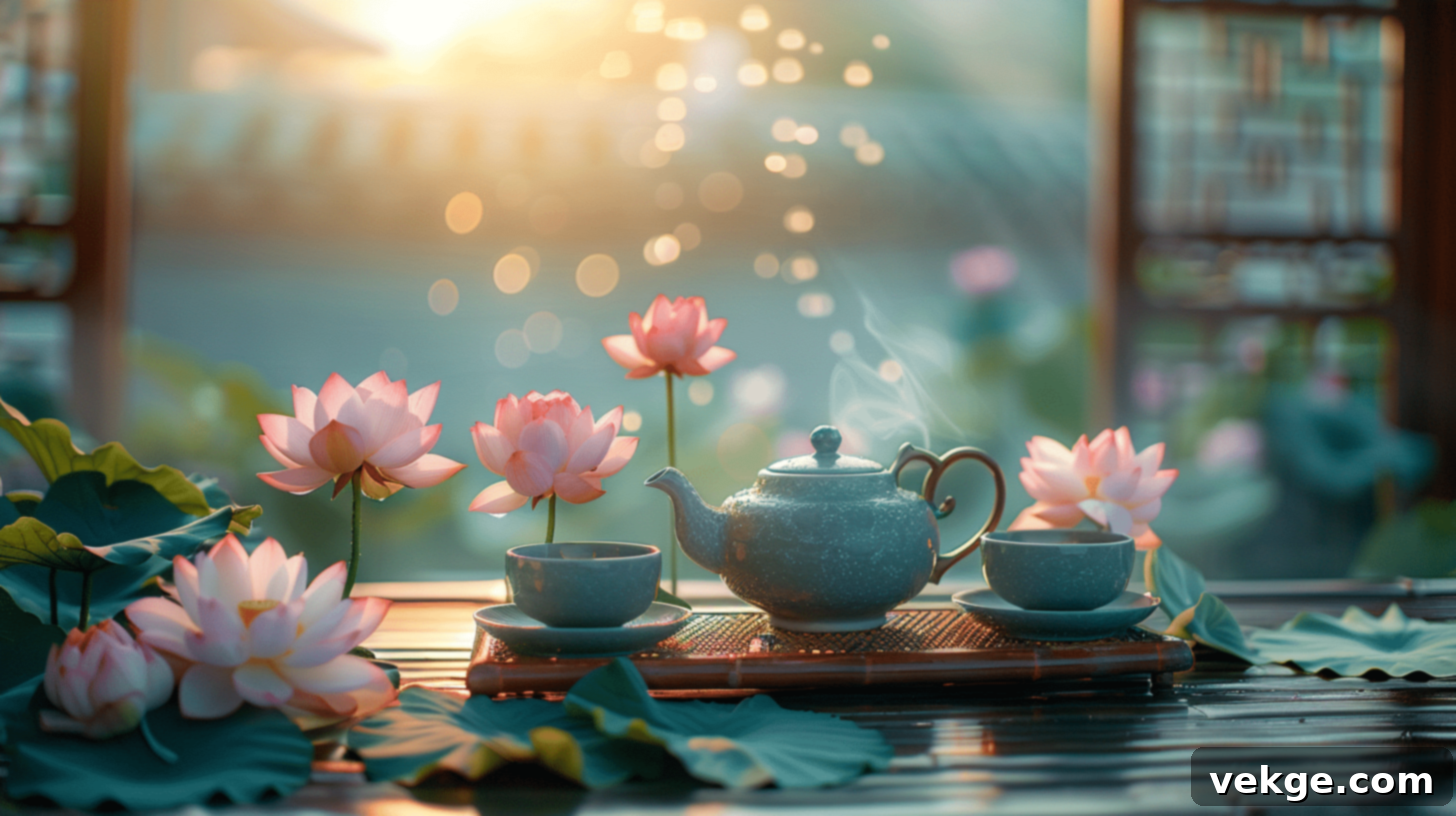
Beyond its striking visual appeal and profound symbolic value, the lotus plant serves as a remarkable source of both nourishment and traditional healing across many cultures, particularly in Asia. This versatile aquatic plant is a testament to nature’s generosity, offering a bounty of edible and medicinal components from its roots to its flowers.
1. Edibility: A Wholly Usable Plant
One of the most fascinating and practical facts about lotus plants is that virtually every part of the plant is edible. This characteristic makes it an exceptionally valuable resource in regions where it grows. From its subterranean roots to its delicate petals and nutrient-rich seeds, humans have ingeniously found ways to incorporate various lotus components into their diets, health practices, and culinary traditions for centuries.
2. Culinary Uses: From Root to Petal
The lotus plant offers a delightful range of textures and flavors, making it a versatile ingredient in many Asian cuisines:
- Lotus Root (Renkon): This crunchy, starchy, and tubular rhizome is a staple in many Asian dishes. It can be prepared in myriad ways: thinly sliced and eaten raw in salads, stir-fried with vegetables and meats, braised in soups and stews, or pickled for a tangy side dish. Its unique lace-like cross-section adds visual appeal, and its mild, slightly sweet flavor makes it highly adaptable.
- Lotus Tea: A popular and calming beverage, lotus tea is enjoyed across China, Korea, and Vietnam. It is typically made by steeping either the dried flowers, fresh petals, or young leaves of the lotus plant. The tea has a delicate, subtly floral aroma and a light, refreshing taste, often consumed for its purported calming and detoxifying properties.
- Lotus Seeds: These small, oval, nutty seeds are highly versatile, finding their way into both savory and sweet preparations. They can be eaten raw (especially when young and fresh), roasted for a crunchy snack, boiled until tender and added to soups or desserts, or ground into a smooth paste (lotus seed paste) which is a key ingredient in many traditional Asian pastries and mooncakes.
- Lotus Stems: The young, tender stems of the lotus plant, often compared to celery in texture, offer a crisp and refreshing addition to various dishes. They are commonly stir-fried or used in salads, providing a pleasant crunch and absorbing flavors from accompanying ingredients.
- Lotus Leaves: Large lotus leaves are not only used for tea but also as a natural wrapping for steaming foods, imparting a subtle, earthy fragrance to dishes like glutinous rice, fish, or dim sum.
3. Health Benefits and Traditional Medicine: Ancient Wisdom, Modern Validation
In traditional Chinese medicine (TCM) and other ancient healing systems, various parts of the lotus plant have been utilized for their therapeutic properties for thousands of years:
- Lotus Seeds: Believed to have a calming and nourishing effect, lotus seeds are traditionally used to alleviate anxiety, combat insomnia, strengthen the spleen, and promote general well-being.
- Lotus Root: In TCM, lotus root is highly valued for its ability to aid digestion, promote blood circulation, and help regulate blood sugar levels. It is also considered cooling, making it beneficial for balancing internal heat.
- Lotus Leaves and Flowers: These parts are often used in herbal preparations to treat fevers, reduce inflammation, stop bleeding (especially the leaf), and detoxify the body. They are also believed to have cooling properties.
- Lotus Stem: The stem is often used to balance the body’s energy (Qi) and is believed to have cooling properties, helping to clear heat and soothe the stomach.
Remarkably, modern scientific research is beginning to provide validation for many of these traditional uses. Studies have shown that lotus plants contain a wealth of bioactive compounds, including flavonoids, alkaloids, and polyphenols, which exhibit significant antioxidant, anti-inflammatory, anti-diabetic, and even anti-cancer properties. This convergence of ancient wisdom and contemporary science further elevates the lotus’s status as a truly remarkable plant.
The exceptional versatility of the lotus in both cuisine and medicine deeply reflects its profound cultural significance. Just as the plant rises from the mud to produce unparalleled beauty, it also provides essential sustenance and potent healing, making it an extraordinary entity in both symbolic representation and practical utility.
Symbolism Across Religions: Universal Lessons from the Lotus

The lotus flower’s meaning transcends its physical beauty, resonating deeply across a multitude of religions, spiritual practices, and philosophical traditions worldwide. As a potent and enduring symbol, the lotus consistently represents profound themes of purity, the extraordinary ability to overcome adversity, and the eternal cycle of rebirth and spiritual renewal. Let’s explore these universal themes in greater depth, understanding how the lotus provides timeless wisdom.
Purity: The Unblemished Bloom
The lotus’s unique and captivating ability to emerge pristine and unsullied from murky, muddy waters has established it as a quintessential and universal symbol of purity. This unparalleled trait resonates profoundly within countless spiritual traditions, offering a powerful metaphor for maintaining one’s inner essence amidst the world’s complexities and defilements.
- In Buddhism, the lotus meticulously represents the purity of body, mind, and speech. It illustrates how one can live in the world, experience its challenges and temptations, yet remain untainted by them, achieving a state of spiritual cleanliness.
- Hinduism views the lotus as a supreme symbol of divine beauty, spiritual purity, and non-attachment. It is often associated with goddesses of purity and prosperity, emphasizing that true beauty comes from inner radiance and spiritual integrity.
- Despite its muddy origins, the flower’s perfectly formed, unblemished petals symbolize the capacity to maintain one’s pure and true nature even when surrounded by a challenging, sometimes corrupting, world. It’s a reminder that inner virtue can persist regardless of external circumstances.
Overcoming Adversity: Resilience and Growth
The lotus’s remarkable growth in difficult, often swampy or muddy environments profoundly symbolizes resilience, perseverance, and the ultimate triumph of the spirit over material circumstances and life’s hardships. Its unwavering ascent from darkness to light serves as an enduring source of inspiration.
- The plant’s inherent ability to thrive and blossom magnificently in conditions that would overwhelm many other flora represents the human capacity to rise above personal struggles, emotional pain, and external challenges. It signifies strength forged through difficulty.
- In mindfulness practices like yoga and Reiki, the lotus is a powerful symbol of emotional healing, personal growth, and transformation. It encourages individuals to move past their suffering and find inner strength, much like the lotus pushing through resistance.
- This symbolism encourages individuals to remain steadfast to their core values, cultivate inner peace, and maintain integrity, even when confronted with troubling times, adversity, or periods of profound despair. It teaches us to bloom despite our roots.
Rebirth: The Cycle of Renewal
The lotus’s fascinating life cycle and its extraordinary botanical properties naturally make it a potent and compelling symbol of rebirth, renewal, and continuous regeneration. Its daily ritual and remarkable longevity speak to the endless possibilities of transformation.
- Its daily blooming cycle, which sees its petals gracefully unfurl with the morning sun and gently close at night, represents continuous renewal, the promise of new beginnings, and the ephemeral beauty of existence. Each day offers a fresh chance to grow and evolve.
- The truly remarkable longevity of lotus seeds, which can lie dormant and remain viable for many centuries before germinating, profoundly symbolizes the enduring nature of the soul, the infinite potential for spiritual awakening, and the promise of life beyond apparent end.
- In many spiritual traditions, the lotus also represents the cyclical nature of birth, death, and rebirth (samsara), encouraging followers to embrace change, growth, and the ongoing journey of spiritual evolution. It’s a reminder that endings are often just new beginnings.
These profound symbolic meanings of the lotus flower effortlessly transcend cultural and religious boundaries, offering universal lessons about human potential, resilience, and spiritual growth. The lotus stands as a constant, gentle reminder that, much like the flower itself, we possess the inherent capability to rise above our circumstances, diligently maintain our inner purity, and continually renew ourselves, blooming beautifully wherever we are planted.
Color Symbolism of the Lotus Flower: A Spectrum of Spiritual Meanings
The universal meaning of the lotus flower is further enriched and nuanced by the specific colors of its blooms. Different hues of lotus flowers carry unique and often profound significance across various cultures and spiritual traditions, adding layers of interpretation to their already rich symbolism. Let’s explore the distinct meanings associated with the four most prominent lotus colors.
White Lotus: Purity and Enlightenment

The white lotus is arguably the most recognized symbol of ultimate purity and spiritual perseverance. Its pristine, unblemished petals beautifully symbolize:
- Mental and Spiritual Purity: It represents a state of complete spiritual and mental cleanliness, free from defilements and attachments.
- The Pilgrimage Towards Enlightenment: The white lotus signifies the journey and dedication required to achieve spiritual awakening (bodhi) and reach a state of inner peace and clarity.
- Relentless Faith and Determination: Its unwavering purity, despite its origins, reflects steadfast faith and the determination to maintain one’s spiritual path.
In Buddhism, the white lotus is frequently associated with the concept of bodhi or awakening, symbolizing a mind purified from all worldly stains and achieving spiritual perfection. In Hinduism, white lotuses are often linked to divine beings and are depicted in association with deities like Saraswati, the goddess of knowledge and arts, signifying her immaculate wisdom.
Pink Lotus: The Lotus of the Buddha

Pink lotuses are universally revered, symbolizing rebirth, profound beauty, and the historical legacy of the Buddha. They specifically represent:
- The Buddha’s Earthly Nature: The pink lotus is often considered the supreme lotus, directly associated with Gautama Buddha, representing his human manifestation and his journey to enlightenment.
- The History of Buddhism: It can symbolize the entire narrative of Buddhism, from its origins to its teachings and widespread influence.
- Divine Beauty and Feminine Grace: In Hindu imagery, the pink lotus frequently symbolizes delicate, feminine energy and is commonly used in depictions of various goddesses, embodying their divine beauty, compassion, and grace.
Red Lotus: Passion and the Heart

The red lotus is a vibrant and powerful emblem, embodying passion, profound love, and bold expression. It intensely signifies:
- Love and Compassion: It represents the pure, unconditional love and deep compassion that radiates from an open heart.
- The Heart and Its Emotions: The red lotus is closely tied to the heart (Hridaya), symbolizing its natural state of purity and the seat of emotions, desire, and selfless affection.
- Boldness and Strength in Adversity: Its striking color often denotes courage and the strength to express true feelings and convictions, even in challenging situations.
In Buddhism, the red lotus is strongly associated with Avalokiteshvara, the bodhisattva of compassion, embodying the original, unadulterated nature of the heart and a love that transcends worldly desires and attachments, aiming for universal well-being.
Blue Lotus: Wisdom and Spiritual Victory

The blue lotus, one of the rarer and more enigmatic varieties, holds unique symbolism often depicted as partially open, suggesting endless potential for discovery. It primarily symbolizes:
- Wisdom and Knowledge: It represents intellectual enlightenment, profound insight, and the pursuit of spiritual knowledge.
- Victory of Spirit Over Senses: The blue lotus signifies the mastery of the mind over the physical senses and material temptations, leading to spiritual liberation.
- The Pilgrimage Towards Enlightenment: Similar to the white lotus, it denotes the unwavering quest for spiritual truth and inner wisdom.
In Buddhist iconography, the blue lotus serves as a potent reminder for practitioners to focus on their innate, Buddha-like characteristics and to develop their wisdom. It symbolizes the ultimate victory of wisdom and profound insight over earthly desires, attachments, and the illusions of the material world, guiding one towards a higher state of consciousness.
Understanding these distinct color meanings adds incredible depth to our appreciation of lotus flowers. Whether encountered in ancient art, used as a focal point in meditation, or simply observed in daily life, the specific color of a lotus can convey powerful and nuanced messages about purity, rebirth, passion, wisdom, and the multifaceted journey of spiritual evolution.
The Lotus in Modern Culture: A Timeless Icon’s Contemporary Bloom
The profound symbolism and exquisite beauty of the lotus flower have shown no signs of fading with time. Instead, this ancient icon has found vibrant new life and relevance in modern culture, particularly influencing personal adornment, fashion, and interior design. The lotus continues to inspire, resonate, and delight in contemporary settings, seamlessly blending its timeless meaning with modern aesthetics.
Tattoos and Jewelry: Personal Emblems of Transformation
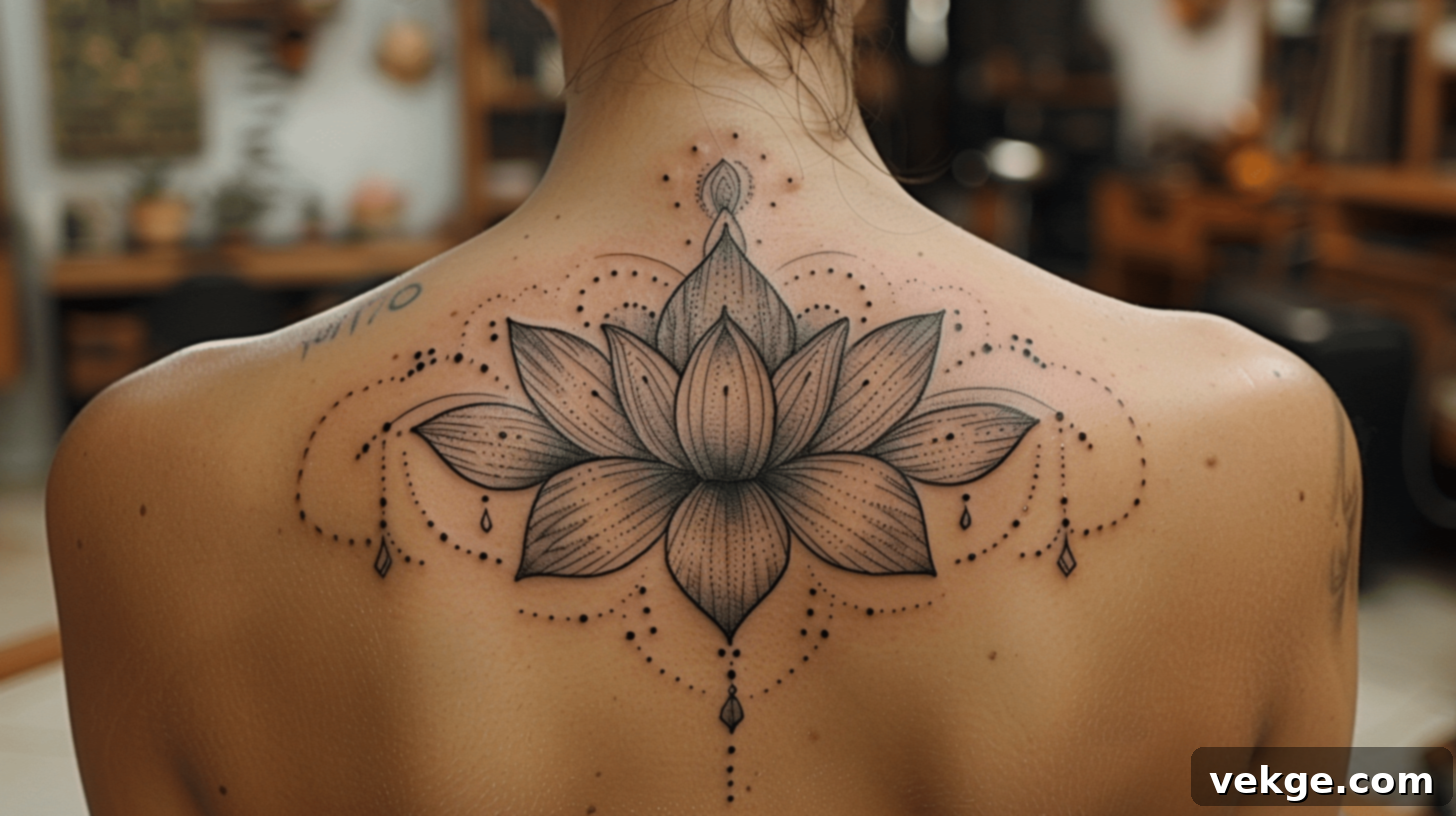
The lotus has become an exceptionally popular choice for tattoos and jewelry, offering individuals a tangible way to carry its rich symbolic meaning and a constant reminder of their personal journeys and aspirations:
- Tattoos: Many individuals opt for lotus tattoos to represent significant personal growth, the triumph over hardship, or a profound spiritual awakening. The flower’s journey from the mud to a beautiful, clean bloom serves as a powerful and deeply personal metaphor for navigating life’s challenges, overcoming adversity, and achieving a state of inner peace and self-realization.
- Jewelry: Lotus-inspired necklaces, earrings, rings, and bracelets are highly sought after not only for their inherent beauty and elegant design but also for their profound symbolism. These pieces often serve as cherished personal reminders of inner strength, resilience, purity, and the wearer’s ongoing spiritual path. Designers incorporate the lotus in minimalist, intricate, and stylized forms, making it adaptable to various fashion sensibilities.
People often select lotus designs that precisely reflect their personal journeys, current aspirations, or spiritual beliefs, making each piece of jewelry or body art uniquely meaningful and deeply personal.
Home Decor and Design: Serenity and Style

The lotus flower’s graceful form, serene elegance, and inherent symbolism have also gracefully made their way into the realms of home decor and interior design, transforming living spaces into havens of peace and beauty:
- Wallpaper and Textiles: Lotus patterns are prominently featured in countless wallpaper designs, fabric prints, and textile art, adding a touch of natural beauty, tranquility, and profound symbolism to living spaces. These patterns range from subtle and minimalist to bold, abstract, and dramatically artistic, fitting diverse interior aesthetics.
- Furniture and Sculptures: Lotus-shaped chairs, tables, or decorative sculptures can serve as striking focal points in a room, seamlessly blending functional form with deep symbolism. Designers create pieces that evoke the flower’s delicate structure and inherent harmony.
- Lighting Fixtures: Lotus-inspired lamps, lanterns, and light fixtures are popular for their ability to create a serene, calming, and almost ethereal atmosphere, mimicking the gentle, diffused glow that seems to emanate from the flower itself.
- Art and Ornaments: From intricate carvings and paintings to decorative bowls and incense holders, lotus motifs are widely used to imbue spaces with a sense of peace, purity, and spiritual connection.
Art Nouveau Influence: Bridging East and West

The lotus was particularly favored and extensively incorporated into the Art Nouveau movement of the late 19th and early 20th centuries, marking a significant moment in its adoption by Western design:
- The movement’s core focus on natural forms, organic lines, and flowing, curvilinear shapes made the lotus an absolutely perfect and quintessential motif. Its inherent grace, symmetry, and elegant curves aligned perfectly with Art Nouveau’s stylistic principles and aesthetic philosophy.
- Lotus motifs appeared ubiquitously in nearly every aspect of Art Nouveau design, from grand architectural elements to everyday utilitarian objects. It influenced the designs of elaborate lampposts, intricate furniture, delicate jewelry, stained glass windows, and decorative items, becoming synonymous with the era’s sophisticated naturalism.
- This historical period played a crucial role in cementing the lotus’s place in Western design and popular culture, significantly expanding its cultural significance beyond its traditional Eastern origins and establishing it as a globally recognized symbol of beauty and artistic inspiration.
Today, the lotus continues to powerfully inspire designers, artists, and individuals across the globe. Its timeless beauty, versatile form, and rich, layered symbolism make it an incredibly adaptable and profoundly meaningful element in modern culture. Whether worn intimately close to the heart as jewelry, proudly displayed as a personal tattoo, or thoughtfully integrated to enhance living and working spaces, the lotus flower’s enduring meaning continues to resonate deeply and inspire powerfully in our contemporary world, proving its eternal relevance.
Final Words: Blooming Through Life’s Challenges
As we conclude our insightful expedition through the captivating world of lotus flowers, we are left with a profound appreciation for their timeless appeal and deep, multifaceted significance. The lotus flower’s meaning is a narrative that effortlessly stretches across diverse cultures and spans millennia, consistently touching upon the universal and deeply human themes of purity, resilience, spiritual rebirth, and the enduring capacity for growth.
From its humble origins rooted firmly in the dark, muddy waters to its pristine, radiant blooms unfurling beautifully towards the sun, the lotus offers us a powerful and inspiring lesson: the inherent strength to rise above our circumstances, no matter how challenging or obscure they may seem. It teaches us that true beauty and purity can emerge from even the most unexpected or difficult environments.
Whether you find yourself drawn to its rich symbolic meaning as a beacon of spiritual enlightenment, its undeniable aesthetic beauty reflected in art and design, or its practical, nourishing uses in cuisine and medicine, the lotus truly offers something meaningful for everyone. It is a symbol that transcends superficiality, speaking directly to the core of human experience and aspiration.
As you reflect on the profound lotus flower’s meaning, consider how its journey can mirror your own. How can you, like the lotus, emerge from life’s inevitable challenges and murky moments with grace, beauty, and unwavering purity of spirit? The lotus reminds us that, within each of us, there resides an extraordinary potential to bloom, to thrive, and to radiate our unique inner beauty, regardless of the soil in which we are planted.
Embrace the lesson of the lotus: find your strength in adversity, maintain your purity amidst chaos, and continually seek renewal, for within you lies the power to blossom brilliantly.
